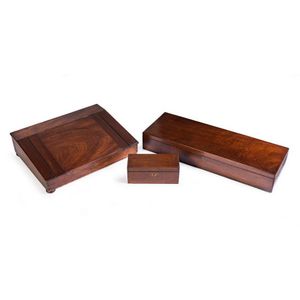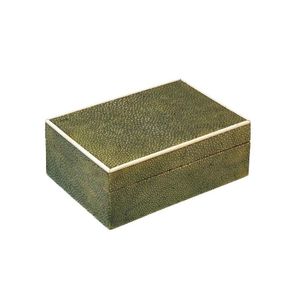1930s Shagreen Boxes with Ivory Band and Satinwood Interior
You must be a subscriber, and be logged in to view price and dealer details.
Subscribe Now to view actual auction price for this item
When you subscribe, you have the option of setting the currency in which to display prices to $Au, $US, $NZ or Stg.
- Satinwood - Satinwood is a dense pale gold coloured timber that was imported into Britain in the second half of the 18th century, and early 19th centuries from the East Indies and the West Indies. The name derives from the satin-like surface sheen when the timber is polished.
It was used in the solid, as a veneer and in inlays. As well as furniture, satinwood was used for making musical instruments, barometers, boxes and clocks.
It will usually be found on only the very best quality objects, presumably because of of its cost at the time. - Shagreen - Shagreen is the untanned smoothly pebbled textured skins of rays, sharks or dogfish. In finishing, it is dyed, mostly green, but the colour often fades to a cream colour. Shagreen was a popular material in Europe during the Art Deco era, when designers sought to mould the French tradition of luxury with exotic and precious materials. Most collectable items made from shagreen are smaller objects, like glasses cases, dagger and sword hilts, dressing accessories, boxes and picture frames.
- Ivory - Ivory is a hard white material that comes from the tusks of elephants, mammoth, walrus and boar, or from the teeth of hippopotamus and whales. The ivory from the African elephant is the most prized source of ivory. Although the mammoth is extinct, tusks are still being unearthed in Russia and offered for sale.
Ivory has been used since the earliest times as a material for sculpture of small items, both in Europe and the east, principally China and Japan.
In Asia ivory has been carved for netsuke, seals, okimono, card cases, fan supports, animals and other figures and even as carved tusks.
In the last 200 years in Europe ivory has been used to carve figures, for elaborate tankards, snuff boxes, cane handles, embroidery and sewing accessories, in jewellery and as inlay on furniture. Its more practical uses include being used for billiard balls, buttons, and a veneers on the top of piano keys.
The use and trade of elephant ivory have become controversial because they have contributed to Due to the decline in elephant populations because of the trade in ivory, the Asian elephant was placed on Appendix One of the Convention on International Trade in Endangered Species (CITES), in 1975, and in January 1990, the African elephant was similarly listed. Under Appendix One, international trade in Asian or African elephant ivory between member countries is forbidden. Unlike trade in elephant tusks, trade in mammoth tusks is legal.
Since the invention of plastics, there have been many attempts to create an artificial ivory
This item has been included into following indexes:
- shagreen items 117
Visually similar items

An Australian cedar writing slope, gun case and glove box, 19th century, the gun case 12 cm high, 77 cm wide, 27 cm deep

Sterling silver card case with double spring lid. Inscribed Richard G. Maguire and Pamela B. Maguire. Maker JW (?), Birmingham 1910. Weight 141.1g

A shagreen and ivory box, stamped London made, 15.5 cm wide

A Tasmanian blackwood and musk glove box, together with a spatter work jewel box, late 19th century, largest 6 cm high, 30 cm wide, 11 cm deep
